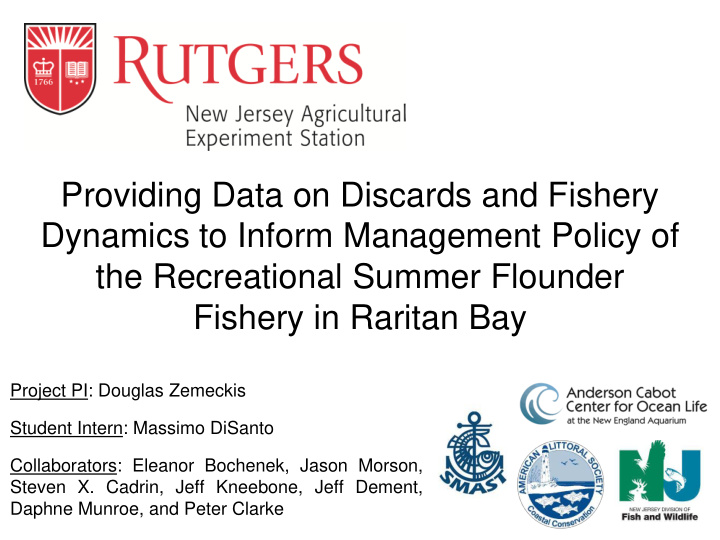



Providing Data on Discards and Fishery Dynamics to Inform Management Policy of the Recreational Summer Flounder Fishery in Raritan Bay Project PI: Douglas Zemeckis Student Intern: Massimo DiSanto Collaborators: Eleanor Bochenek, Jason Morson, Steven X. Cadrin, Jeff Kneebone, Jeff Dement, Daphne Munroe, and Peter Clarke
New Jersey’s Fisheries • Total economic impacts of the NJ recreational fishing industry was estimated at $1.2 billion in 2015 (NOAA, 2016). • Approximately 1 million total anglers taking 4-7 million trips annually. • Most common: summer flounder , black sea bass, bluefish, striped bass, tautog. NJDEP
Summer Flounder ( Paralichthys dentatus ) Terceiro (2016) https://www.nefsc.noaa.gov/sos/spsyn/fldrs/summer/
Summer Flounder ( Paralichthys dentatus ) • NJ’s recreational fishery (2006 -2015): 0.5 -1.5 million fish landed annually, while 4-10 million fish are discarded annually. • 10% discard mortality rate currently assumed. Morson et al. (2017)
Angler Survey • Additional data on angler fishing practices and behaviors was needed to better understand fishery dynamics, inform management, to develop extension education materials, and to guide future research. • An angler survey (n=28 questions) was distributed using Qualtrics focusing on: – Fishing experience – Locations fished – Tackle types used – Capture and handling practices
Angler Survey • A total of 299 anglers from throughout NJ completed the online survey. – The survey did a great job at reaching experienced private boat anglers (70% of respondents). 20 250 Number of Respondents Number of Respondents 18 16 200 14 12 150 10 8 6 100 4 2 50 0 0 Bait Rig Jig Rig Size of Hooks Terminal Tackle Rig
Sex Ratios • A non-invasive method for externally identifying the sex of summer flounder would be valuable for fishery monitoring and future tagging studies. • Three potential approaches were tested during sampling of commercial landings: – Location of genital pore – Cannulation – Morphometrics Photo Credit: Mark Wuenschel (NOAA)
Male Female - Most variation is sized based (PC1) - No strong differences in body shape (PC2)
Acknowledgements • Research funding was provided by the Rutgers Raritan River Consortium’s Mini -Grant/Internship Pool. • Thanks to all of the recreational anglers who completed the fishing tackle and behavior survey. • Thanks to the collaborating commercial fishing and seafood companies who assisted with summer flounder sampling: – Belford Seafood Cooperative – Fisherman’s Dock Cooperative – Sally’s Seafood – Trinity Seafood
Recommend
More recommend